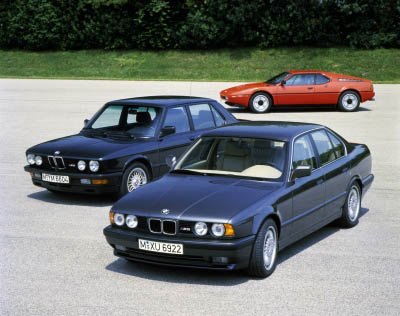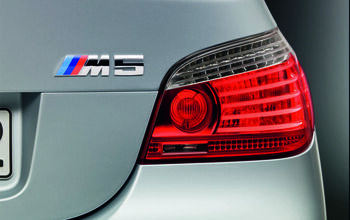40 Years Of The M Series - A Pictorial History. Chapter 2

In the first chapter, we watched how BMW’s in-house motorsports department morphed into a separate company, that soon made its own cars. 16 years later ….
In 1988, the BMW M5 saw its second generation. The straight-six was pumped up to 3.8 liters, its power rose to 340 hp.
To confuse people, the engines dropped the “M” in their internal production code. The M was replaced by an S. To more than make up for the lost letter, the valve covers now sported a big M.
The next 3 Series was set to make its appearance in 1990.
Motorsport GmbH had advance notice, and was already working on the new BMW M3 which was launched in 1992. The new M3 lost its big spoilers and bulging wheel arches. Reflecting the more understated signs of the times, the new M3 looked more discreet. But you could hear it right away. The sound created by the three-liter six was unmistakable. The four-valve plant produced up to 286 hp. It was also BMW’s first engine with VANOS variable valve timing, an infinitely adjustable system varying the intake camshaft.
Customers and the media loved this M3 right from the start. Immediately, the order books were bulging more than the old wheel arches. Awards, from multiple “Car of the Year” to one “Car of the Century,” rained on the M3.
Instead of chopping off the roof as an afterthought – the usual genesis of a ragtop – a convertible was included in the planning process right from the early start.
Fort the racetrack, the M3 GT was produced in a small, special series. It moved up the performance benchmark to 295 hp. From 1992 to 1996, Motorsport GmbH built more than 85 four-door racing 3 Series based on this M3. Amongst the many wins, it brought home the IMSA title in 1996.
If you wanted an M3 – or for that matter any BMW – that nobody else had, then you could order it from BMW Individual, a business unit started by Motorsport GmbH in 1992. Whatever the customer wanted, BMW Individual made it happen – for a price. With BMW Individual, Motorsport GmbH was a pioneer in the market. Soon, other mass market makers copied the idea, and even the name.
With all these activities, “Motorsport GmbH” became a bit cumbersome and limited. On 1 August 1993, the former Motorsport GmbH was re-christened BMW M GmbH.
In 1995, the M3 received even a little more power, 321 hp from 3.2 liters. Double VANOS variable timing was used for the first time.
The BMW M GmbH became the first car maker in the world to introduce the Sequential M Gearbox (SMG), which debuted in the M3. To shift gears, you pulled or pushed the gear lever up and down one level. There was no clutch pedal: The SMG activated the clutch electrohydraulically when changing gears. In the beginning, drivers furrowed their foreheads about this new-fangled technology, but soon, almost every other BMW M3 was fitted with the SMG.
Also in 1995, a big six-liter 12-cylinder based on the 750i engine powered the closed-top McLaren sports car to victory in the 24 Hour Race at Le Mans. Four-valve technology, a titanium crankshaft and an aluminum clutch helped to give the V12 maximum output of more than 600 hp.
In 1995,BMW Motorsport Ltd was established in the United Kingdom, taking over all of BMW’s motor-sport activities. M GmbH concentrated on M Cars, BMW Individual and Driver Training.
1997 brought the M roadster, an eye-watering combination of the Z3 roadster with the 321 hp power unit of the M3.
The M coupé followed shortly thereafter.
What will also follow is the third and last chapter.

Bertel Schmitt comes back to journalism after taking a 35 year break in advertising and marketing. He ran and owned advertising agencies in Duesseldorf, Germany, and New York City. Volkswagen A.G. was Bertel's most important corporate account. Schmitt's advertising and marketing career touched many corners of the industry with a special focus on automotive products and services. Since 2004, he lives in Japan and China with his wife <a href="http://www.tomokoandbertel.com"> Tomoko </a>. Bertel Schmitt is a founding board member of the <a href="http://www.offshoresuperseries.com"> Offshore Super Series </a>, an American offshore powerboat racing organization. He is co-owner of the racing team Typhoon.
More by Bertel Schmitt
Latest Car Reviews
Read moreLatest Product Reviews
Read moreRecent Comments
- ToolGuy Please allow me to listen to the podcast before commenting. (This is the way my mind works, please forgive me.)
- ToolGuy My ancient sedan (19 years lol) matches the turbo Mazda 0-60 (on paper) while delivering better highway fuel economy, so let's just say I don't see a compelling reason to 'upgrade' and by the way HOW HAVE ICE POWERTRAIN ENGINEERS BEEN SPENDING THEIR TIME never mind I think I know. 😉
- FreedMike This was the Official Affluent-Mom Character Mobile in just about every TV show and movie in the Aughts.
- Offbeat Oddity The RAV4, and I say this as someone who currently owns a 2014 CR-V. My aunt has a 2018 CR-V that has had a lot of electrical issues, and I don't trust the turbo and CVT to last as long as Toyota's NA engine and 8-speed automatic. Plus, the RAV4 looks sportier and doesn't have the huge front overhang.
- Offbeat Oddity I'd go with Mazda, especially now that there's no more cylinder deactivation on the 2024 NA motor. It's around $4-5k less than the Toyota with similar equipment, and I think reliability is probably very close between them.Regarding reliability, hasn't this generation of RAV4 taken a hit? I know it's not rated as highly in Consumer Reports, and there were teething issues during the first few years. I'm surprised it's not mentioned in more reviews- even Jack Baruth's. I'm sure the bugs have been worked out by now, though.












































Comments
Join the conversation
This is a PARTIAL history, not a PICTORIAL history, Do your research and get it right or don't do it at all.
One might also respectfully point out that four valve technology was scarcely worthy of a mention in a Toyota Camry's spec sheet in 1995. Four valve technology was already de rigeur in high end exotic sports cars by the 1930's. Furthermore 600hp out of a 6litre engine engine is hardly breathtaking power.